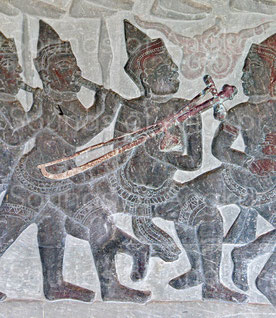Update: December 5, 2023
The stick zither with a single resonator is attested from the 7th century on a lintel of Sambor Prei Kuk preserved in the National Museum of Cambodia, on a high-relief of the Phnom Chisor (11th century) and on a bas-relief in the north gallery of Angkor Wat (16th century).
Position of the resonator during playing
About the zither of the bas-relief of Sambor Prei Kuk (picture 1), the resonator rests on the chest of the musician. For that of the north gallery of Angkor Wat (photo 3) the sculptor had the concern to show the details of the instrument: peg and string. This is why the instrument is represented in profile. However, if we visualize the zither in its true position of playing, the resonator takes place on the chest of the musician and the angle formed by the instrument in relation to the character is conformed both to the model of the 7th century and to contemporary practices.
Nature of materials
The sculpture reveals anything about the material used to make the neck. It may be assumed that there were made of wood or bamboo. However, the inscription of Prasat Komphus (K.669) at the end of the 7th c. tell us that the temple received nine zithers made of a metal in copper alloy and another covered with gold.
The resonators are of variable sizes. Two local materials could be used: the coconut and the calabash. The calabash, of the genus Lagenaria, is a herbaceous creeping plant of the family Curcurbitaceae. Information published by French ethnomusicologist Jacques Brunet during 1960s reports that it grew naturally in the Cardamom forest. There are various forms, but it is probably the piriform fruits that composed the resonator of zithers. If one refers to current practices, the calabashes are dried, cut to size, hollowed out, sometimes decorated by etching and then attached to the neck.
Strings
The material making up the strings is unknown, but if we refer to ethnology, some are made of vegetable fibers. However, the use of the hose or silk cannot be ruled out. As to metal, which is the most suitable material for obtaining a clear and powerful sound, we don't know if there existed in those ancient periods bronze or brass strings sufficiently fine to sound and resistant enough to withstand the tension. We carried out tests with silk ropes of different diameters on a contemporary kse diev ខ្សែដៀវ. There is no more difficulty in generating the harmonics than with a metal string, but the sound lacks clarity, duration and power, which leads us to think that the musicians used metal strings, perhaps made of brass, as is still the case today in Cambodia
The zither on a mono-resonator stick outside Cambodia
The stick zither with a single resonator, of Indian origin, has followed certain paths of Hinduism and Buddhism. It can be found in the iconography of the Buddhist temple of Borobudur in Java (Indonesia).
Zither through epigraphy
Various terms appear in epigraphy to designate zither from 7th to 10th century:
- The inscription of Angkor Borei (K. 557 & K 600 / 611 A.D.) mentions the term kañjaṅ. Until now, this word is an enigma for the researchers. The later inscriptions of Lolei (9th century) always have the same descriptive hierarchy concerning the temple servants (all female), namely for the chordophones: tmiṅ kinnara - zither players, tmiṅ vīṇa - harp players, tmiṅ lāv - lāv lute (?) player. In the case of the inscription of Angkor Borei, the hierarchy is as follows: tmiṅ kañjaṅ, tmiṅ vīṇa, tmiṅ lāhv. By crossing the iconography of the 7th century (picture 1) with this inscription, it can be correctly assumed that kañjaṅ designates a monochord zither. The root of this word derives from the Sanskrit guṇa designating the string of a musical instrument.
- The 9th century inscriptions of Lolei temple (K. 324S & N, 327S & N, 330S & N, 331S & N) mention the presence of three different tmiṅ kinnara (zither players) for each week of the lunar calendar, light and dark. Kinnara also derive from the Sanskrit word guṇa.
- The inscription of Prasat Komphus (K. 669 / 972-973 A.D.) teaches us that the temple received ten kinnara zithers, one of which was covered with gold.
The contemporary stick zither with a single resonator
The contemporary stick zither with a single resonator is called kse diev or khse muoy, which means "one string". Its practice was already rarefied in the 1960s and it had almost disappeared after the Khmer Rouge revolution, most musicians having been exterminated. Thanks to the tenacity of the late Master Sok Duch, several musicians of the younger generation can now ensure its continuity. You can listen here to one of the best of them: Sinat Somnang.
Such a zither with two to seven strings is also played in Thailand where it is called phin pia or phin phia.










